RAF Goxhill
Royal Air Force Goxhill or RAF Goxhill is a former Royal Air Force station located east of Goxhill, on the south bank of the Humber Estuary, opposite the city of Kingston upon Hull, in north Lincolnshire, England.
| RAF Goxhill USAAF Station 345 .png)  | |
|---|---|
| Located Near Goxhill, Lincolnshire in England | |
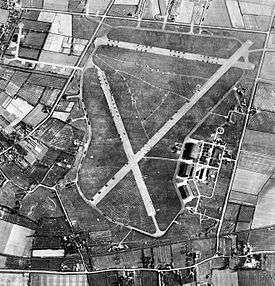 RAF Aerial photograph of Goxhill airfield. taken on 29 April 1947. The runways are blocked with different types of equipment. Also, the control tower and technical site with two T2 hangars and a J-Type hangar is on the right. | |
 RAF Goxhill RAF Goxhill shown within Lincolnshire (grid reference TA110210) | |
| Coordinates | 53°40′40″N 000°18′56″W |
| Type | Royal Air Force station |
| Code | GX |
| Site information | |
| Owner | Ministry of Defence |
| Controlled by | Royal Air Force United States Army Air Forces |
| Site history | |
| Built | 1940 |
| In use | 1940-1953 |
| Battles/wars | European Theatre of World War II Air Offensive, Europe July 1942 - May 1945 |
| Garrison information | |
| Garrison | RAF Bomber Command RAF Fighter Command Eighth Air Force Ninth Air Force |
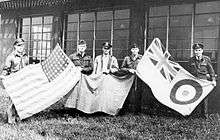
Origins
During the First World War a Royal Flying Corps landing ground existed near the Lincolnshire village of Goxhill. In 1940 the Air Ministry returned to survey the land once again for its suitability as an airfield.[1]
Royal Air Force use
Goxhill was originally used as a barrage balloon site to protect the port of Hull and the River Humber.
In 1940, Goxhill was transferred to RAF Bomber Command and was planned and rebuilt as a bomber airfield. It was equipped with three intersecting runways, the main runway at 1,600 yards (1,500 m) and two secondary runways of 1,100 yards (1,000 m).[2] Three hangars were built: two T-2s, one J-Type and four blisters and fifty aircraft hardstands. Temporary accommodation was provided for 1700+ personnel.
Its location, however, was too close to the air defences of Hull to be used for that purpose. Its first occupant was No. 1 Group, which took up residence on 26 June 1941. Its mission was towing practice targets with Westland Lysanders; its first operation began on 25 October.[3]
In December 1941, RAF Fighter Command replaced the Bomber Command training unit with No. 12 Group, flying Supermarine Spitfires from No. 616 Squadron at RAF Kirton in Lindsey. Fighter Command operated the base until May 1942.
United States Army Air Forces use
The airfield was relegated to satellite field use by RAF Kirmington until August 1942, when it was taken over by the United States Army Air Forces (USAAF). The transfer ceremony was attended by General Dwight D. Eisenhower.[4] During the war it was known as USAAF Station 345.[3]
The facilities at Goxhill, however, left a lot to be desired. Three wooden barracks were supplemented by a number of metal fabricated buildings for living quarters. Typical of the temporary RAF station of that period, living quarters and mess facilities were 1 to 2 miles from the hangars and flight operations area for safety reasons.
The station was unofficially known by the USAAF units based here as "GoatHill".[5][3] The USAAF used Goxhill as a training airfield for the rest of the war; several squadrons used it after their initial deployment to the UK, then moved on to a permanent facility for their operational missions.
USAAF Station Units assigned to RAF Goxhill were:[6]
- 333rd Service Group[7]
- 332rd Service Squadron; HHS 333d Service Group
- 13th Station Complement Squadron
- 18th Weather Squadron
- 2nd Gunnery & Tow Target Flight
- 1004th Signal Company
- 1148th Quartermaster Company
- 1275th Military Police Company
- 1771st Ordnance Supply & Maintenance Company
- 2130th Engineer Fire Fighting Platoon
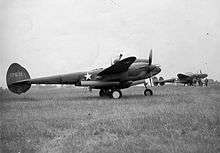
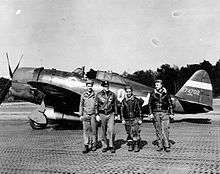
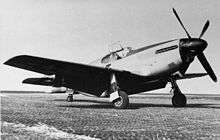
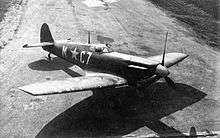
Both the USAAF 8th and 9th Air Force used Goxhill. Units which trained here were:
| Group | Aircraft | Date Arrived | Date Departed |
|---|---|---|---|
| 1st Fighter Group | Lockheed P-38 Lightning | 10 June 1942 | 24 August 1942 |
| 52nd Fighter Group | Bell P-39 Airacobra | 26 August 1942 | 9 November 1942 |
| 78th Fighter Group | P-38 Lightning P-47 Thunderbolt |
1 December 1942 | 6 April 1943 |
| 353rd Fighter Group | Republic P-47 Thunderbolt | 7 June 1943 | 3 August 1943 |
| 356th Fighter Group | P-47 Thunderbolt | 27 August 1943 | 5 October 1943 |
| 358th Fighter Group | P-47 Thunderbolt | 20 October 1943 | 29 November 1943 |
| 496th Fighter Training Group | North American P-51 Mustang P-38 Lightning |
25 December 1943 | 15 February 1945 |
The 496th Fighter Group was a Combat Crew Replacement Center for 8th and 9th USAAF units. It consisted of the 554th Fighter Squadron with P-38s and the 555th Fighter Squadron with North American P-51 Mustangs. The group trained over 2,400 fighter pilots during its existence. The 78th Fighter Group came to England equipped with P-38s, but had all of its aircraft and most of its pilots sent to the Twelfth Air Force in February 1943, after which it flew P-47 Thunderbolts.[8]
Post-war military use
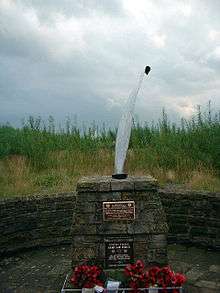
On 20 January 1945, the USAAF returned Goxhill to RAF control, and it was assigned as a satellite to RAF Kirton In Lindsey. On 27 May 1945 it was assigned to RAF Maintenance Command for storage of excess munitions. RAF Goxhill remained a storage depot until it was deactivated on 14 December 1953.[9]
Goxhill airfield was leased to farmers for agricultural use until 29 January 1962, when it was finally sold by the Ministry of Defence (MoD). The technical site and the hangars, however, were retained by the MoD for storage. In July 1977, the MoD sold off the remaining parts of Goxhill to private owners for agricultural use.[10]
Agricultural use
Since the end of its military use, Goxhill airfield has remained remarkably intact, with a Mary Celeste feel about it. Perhaps because of its relative inaccessibility, Goxhill still looks very much as it did during the war years.[1] All the buildings on the technical site, except the control tower which was partly demolished (despite the owner's objection) in 2002, are still standing.[4] The three hangars—two T.2s and a J type—are also there, albeit in a state of disrepair. The perimeter track is almost complete, and a large part of the main runway is still in place. In the northwest corner of the site is a memorial incorporating a propeller blade from a crashed P-38. The remains of the control tower were acquired by the Military Aviation Museum in Pungo, Virginia, USA, and after careful dis-assembly and cataloging, the components were shipped to America, where the tower has been reconstructed for use by the museum.[4]
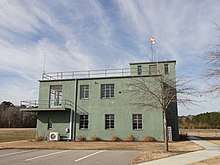
References
![]()
Citations
- "Goxhill Airfield History - BCAR.org.uk". www.bcar.org.uk. Retrieved 19 May 2017.
- Delve 2008, p. 155.
- Delve 2008, p. 153.
- "RAF Goxhill watch office reopens in US". BBC News. 18 May 2017. Retrieved 18 May 2017.
- "Goxhill - Airfields of Britain Conservation Trust UK". www.abct.org.uk. Retrieved 19 May 2017.
- "Goxhill". American Air Museum in Britain. Retrieved 9 March 2015.
- "332d Service Group". American Air Museum in Britain. Retrieved 9 March 2015.
- Delve 2008, pp. 155-156.
- Historic England. "Goxhill Airfield (1395792)". PastScape. Retrieved 19 May 2017.
- Delve 2008, p. 154.
Bibliography
- Bruce Barrymore Halpenny Action Stations: Wartime Military Airfields of Lincolnshire and the East Midlands v. 2 (ISBN 978-0850594843)
- Delve, Ken (2008). The Military Airfields of Britain; the East Midlands. Marlborough: Crowood Press. ISBN 978-1-86126-995-9.
- Freeman, Roger A., Airfields Of The Eighth, Then And Now, 1978
- Maurer Maurer, Air Force Combat Units Of World War II, Office of Air Force History, 1983
- Parker, Ron Goxhill At War, 1994
- Parker, Ron A Village At War Goxhill, 1996
- USAAS-USAAC-USAAF-USAF Aircraft Serial Numbers--1908 to present
External links
| Wikimedia Commons has media related to RAF Goxhill. |
- 496th Fighter Training Group History—This opens up a pdf file and not a web page. (i.e. html)
- United States Army Air Forces - Goxhill
- Historic Goxhill photo.htm
- RAF Goxhill North Lincolnshire Airfield
